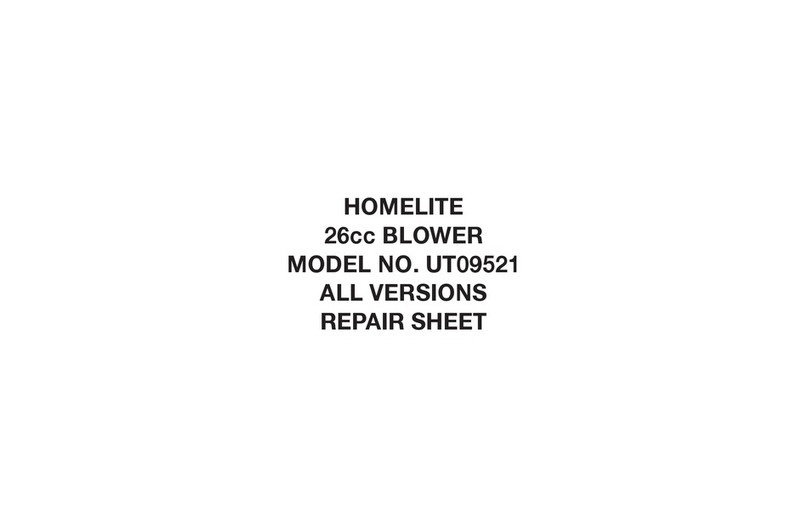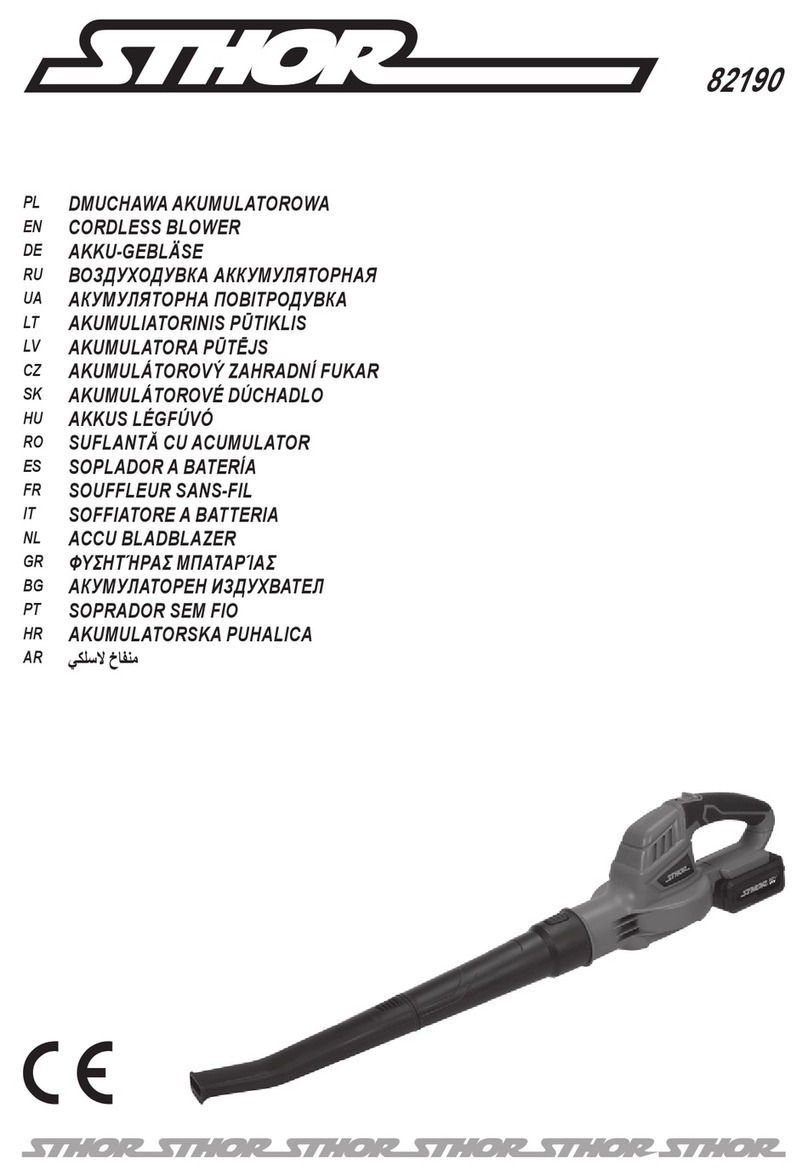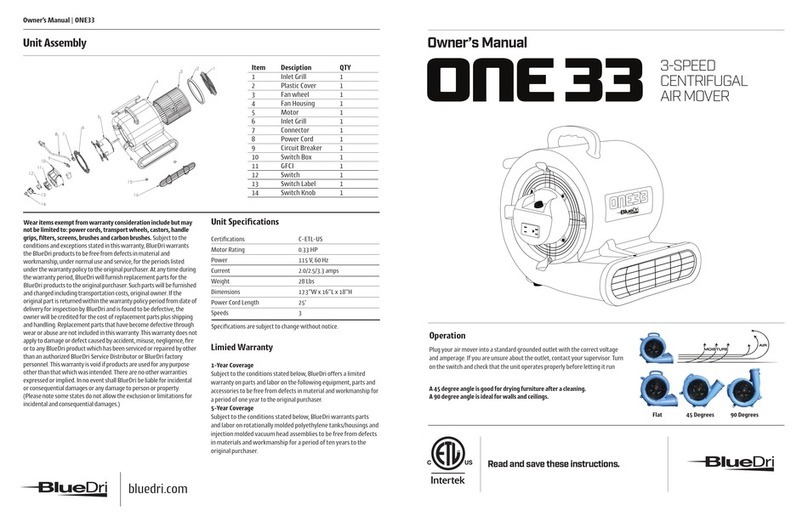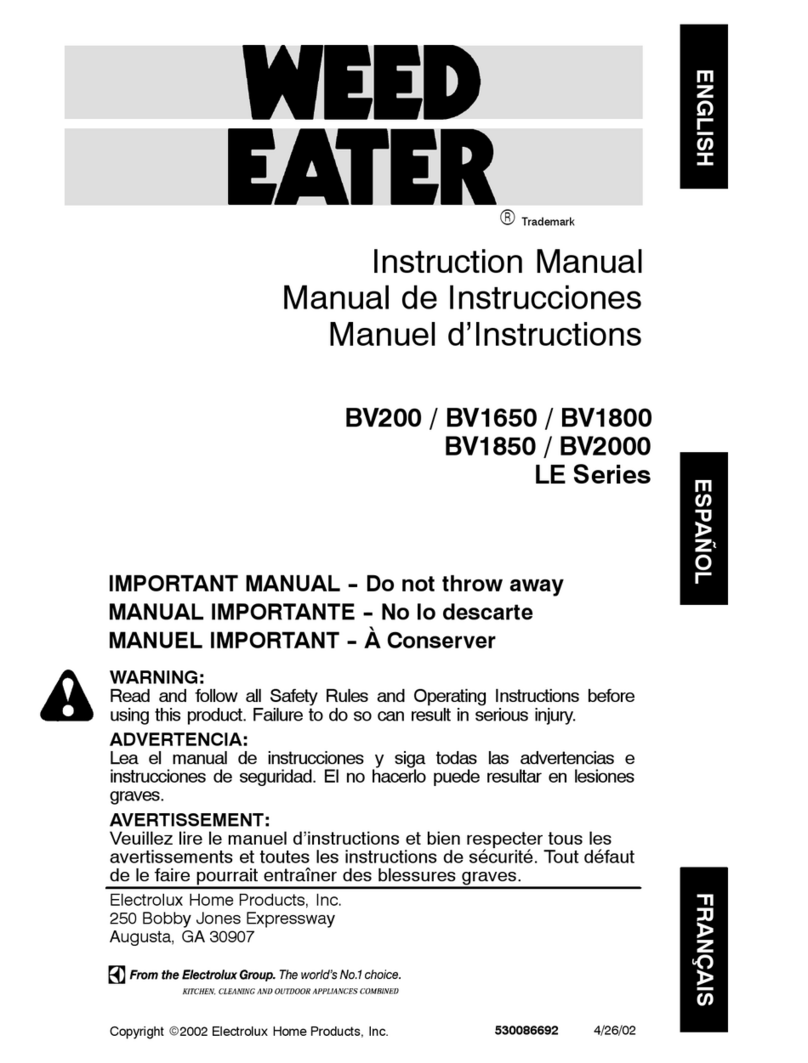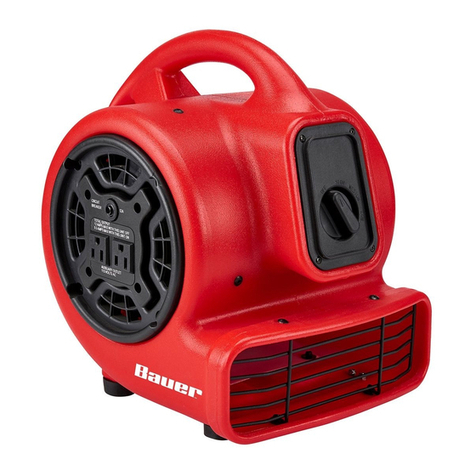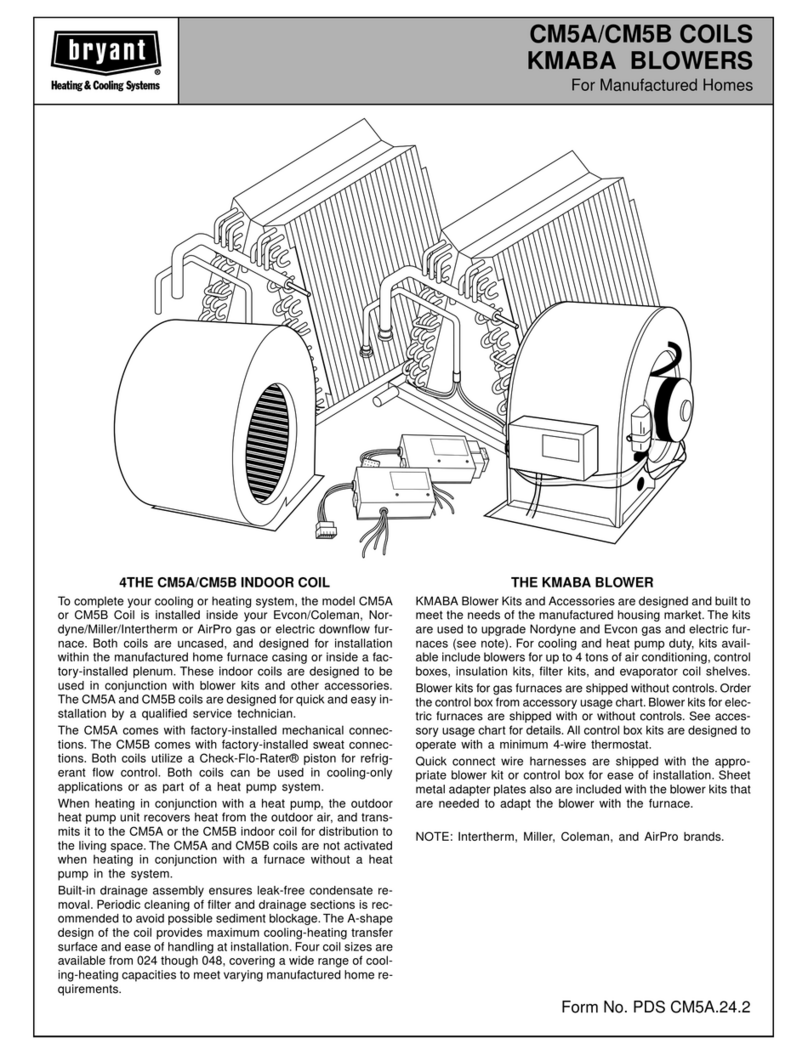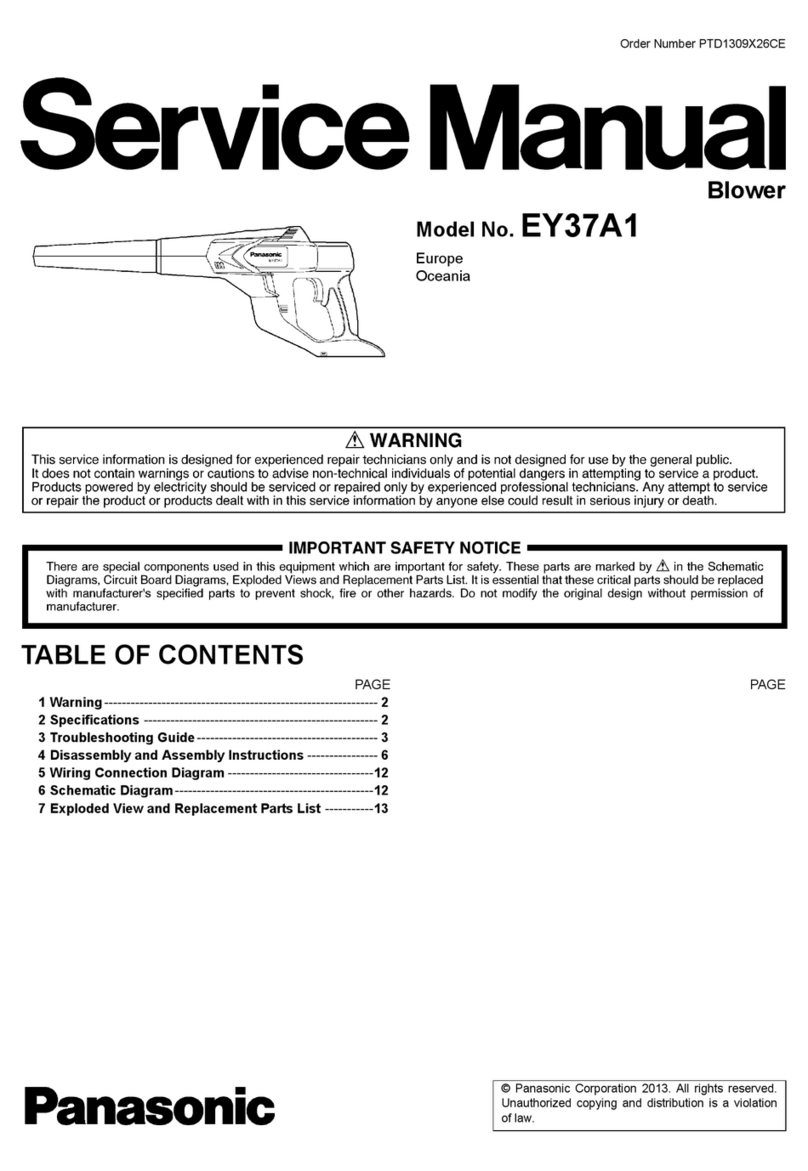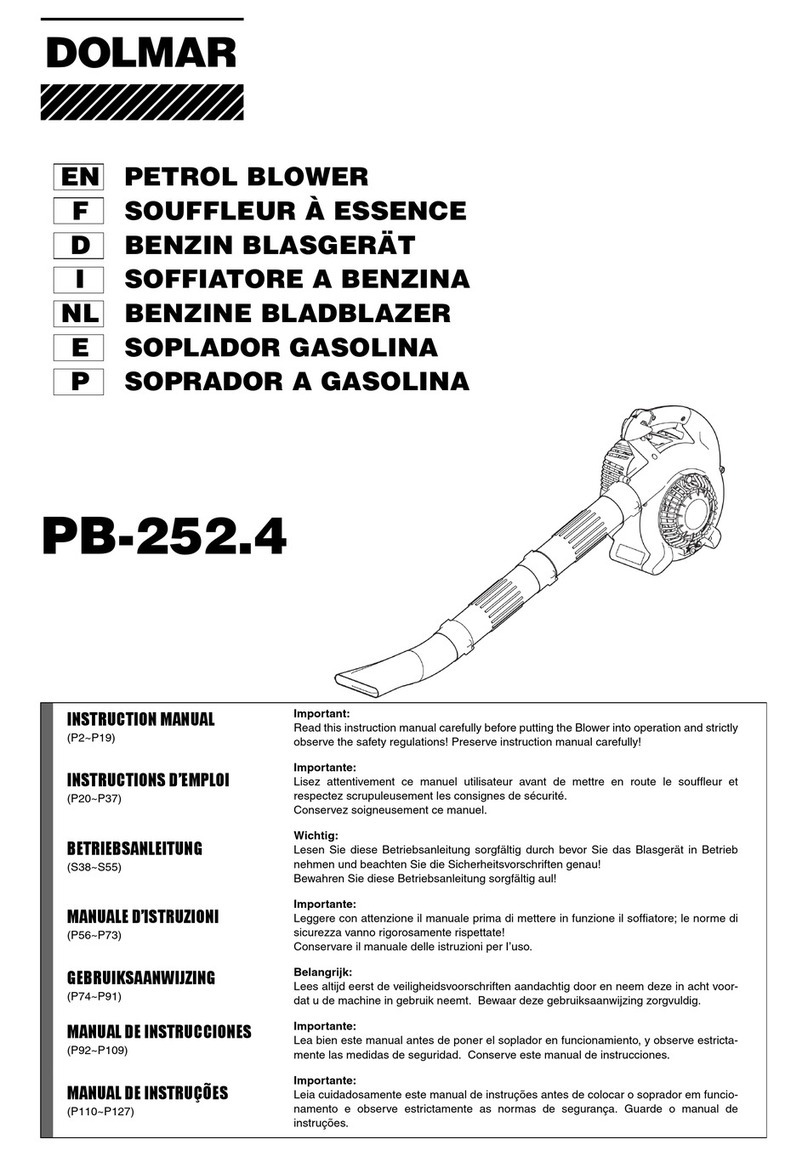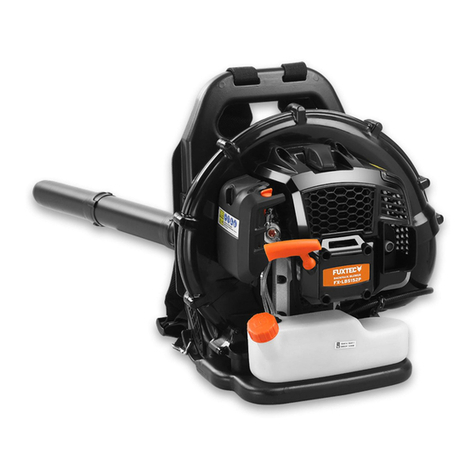Sherpa STWV58L User manual

OWNER’S MANUAL
WHEELED LEAF VACUUM
MODEL: STWV58L
IMPORTANT! IT IS ESSENTIAL THAT YOU READ THE INSTRUCTIONS IN THIS
MANUAL BEFORE ASSEMBLING, OPERATING AND MAINTAINING THIS PRODUCT.

2

3
Included accessories
Accessories
1)Collection Bag Fixing Bracket
2)Collection Bag
3)Auxiliary Hose - Optional Extra Included With Hose Kit
4)Suction Port Baffle - Optional Extra Included With Hose Kit
5)Hose Bracket
6)Guide Wheel
Warning: For your own safety, please read this manual before using this machine for the first
time. Failure to follow instructions can result in serious personal injury. Take time to familiarise
yourself with the machine before each use.
2
1
5
3
4
6

4
WARNING:
If any of the labels are damaged or missing, replace them before operating the equipment.
Safety and specification introduction
1)Product safety warning
General security warning:
WARNING: When using petrol tools, always follow basic safety precautions (including the following) to reduce the risk of serious
personal injury and/or equipment damage.
Read all of these instructions before operating this product and keep these instructions for future reference.
————————————————————————————————————————————————————————————
Training:
•Please read the instructions carefully. Familiarise yourself with the control and proper use of the equipment.
•Do not allow children or people who are not familiar with these instructions to use the device.
•Do not work with people or animals nearby.
•The operator is responsible for accidental injury or danger to their own or others property.
————————————————————————————————————————————————————————————
Preparation and rule content:
•Wear protective shoes and trousers when operating the equipment. Do not operate the equipment barefoot or wearing sandals.
•Thoroughly check the area where the equipment is used and remove any debris or items that could damage you or the machine.
•Warning - Petrol is extremely flammable.
oStore fuel in containers specially designed for this purpose.
oOnly refuel outdoors, do not smoke when refueling.
oAdd fuel before starting the engine. Never remove the fuel tank cap or add petrol while the engine is running or the engine is hot.
oIf the petrol overflows, do not attempt to start the engine. Instead, move the machine away from the spill area and avoid creating any
ignition source before the petrol vapor dissipates.
oReplace all fuel tank caps and container lids.
•Check visually before use to see if the impeller, impeller bolt and shaft connection are worn or damaged. Replace worn or damaged impeller,
impeller bolts and shaft couplings to maintain balance and reliability.
•Do not operate the machine in small or confined spaces. For outdoor use only.
•Only operate in daylight or artificial light.
•For collection of dry material only.
•Please ensure your safety when working on slopes.
•Never operate on slope above specified maximum gradient.
•Use at normal walking speed and do not run with the machine.
•Be extremely careful when changing direction on slopes.
•Do not work on excessively steep slopes.
•Do not change the engine governor settings or overspeed engine.
•Carefully start the engine as described, with your hands and feet away from any ports on the machine.
•Do not tilt the device when starting the engine.
•Do not pick up or carry the machine while the engine is running.
•Stop the engine and disconnect the spark plug wires to ensure that all moving parts have stopped completely;
oBefore clearing the blockage or clearing the chute.
oBefore checking, cleaning or working on the equipment.
oAfter hitting a foreign object. Inspect the equipment for damage and repair before restarting and operating the equipment.
oIf the machine starts to vibrate abnormally, stop the machine and check immediately.
oWhenever you leave the machine;- before refueling;
●Replace worn or damaged parts for safety;
●If the tank must be emptied, it should be done outdoors.
Warning: Do not touch any rotating parts
Warning: Only run the engine in a well ventilated area

5
2)Warning Label
A.1 A.2 A.3 A.4 A.5
Fig.1
A.1 Read the operating manual.
A.2 Keep bystanders at a safe distance.
A.3 Do not touch the rotating parts while operating.
A.4 Toxic gases; do not operate inside the house.
A.5 Please wear protective gloves; pay more attention to your
hands and feet to avoid injury.
A.6 When repairing, please pick up the spark plug and repair it
according to the operation manual.
A.7 Caution: The engine is hot.
A.8 Wear glasses and earplugs to protect the operator.
A.6 A.7 A.8
———————————————————————————————————————————————————————————————
3)Throttle Control
Fig.3
LC1P65FC Throttle Control
———————————————————————————————————————————————————————————————
4)Data Plate
Fig.5.2
———————————————————————————————————————————————————————————————
High Speed
Low Speed
Stop

6
Assembly instructions
Assembly is required before use. Please understand the name and function of each part on the second page of this manual,
and then assemble it with the installation steps described in the following figure. Note: The shape of the part contained in the
assembly diagram is not inconsistent with the actual part shape.
Assembly step 1)Upper handle assembly - Please put the upper handle bar assembly (1) on the lower handle bar (2), guide
according to the dotted line, and then insert the two bolts (4) through the mounting holes, and tighten the handwheel (3) firmly.
Fig.7-1 Assembly guide
Fig.7-2 Assembly completion diagram
1 - Upper Handle Assembly
2 - Lower Handle Assembly
3 - Handwheel Knob M8
4 - Semi-circular Head square Neck Bolt (M8X46)
1
4
2
3

7
Assembly step 2)Collection bag fixing bracket assembly—Insert the left and right ends of the collection bag fixing bracket into the
corresponding four holes on the upper handle bar assembly.
Fig.8-1 Assembly guide
Fig.8-2 Assembly completion diagram
Assembly step 3)Hose bracket assembly -Insert the left and right ends of the hose bracket into the corresponding two holes on the
upper grab bar assembly.
Fig.9-1 Assembly guide Fig.9-2 Assembly completion diagram
Assembly step 4)Collection bag assembly—Slide the upper layer of the collection bag into the collection bag fixing bracket. The left
and right clips are fastened to the bracket. Hang the two left and right hanging plates on the ends of the hose fixing bracket. Press the
baffle catch and open the rear cover,Insert the collection bag interface into the back cover bracket.
Fig.10-1 Nested into the collection bag Fig.10-2 Fastening Card strip Fig.10-3 Assembly hanging board
Clips

8
Fig.10-4 Fig.10-5 Press the baffle and open the rear cover Fig.10-6 Insert back cover bracket
Fig.10-7 Insert in place Fig.10-8 Installation completion diagram
Hanging Board
Baffle
Catch

9
△Assembly step 5)Auxiliary hose assembly—Open the cover on the suction port, align the end of the hose into the interface fixing
bracket, and tighten it to the right according to the marking indication on the interface fixing bracket.
Fig.12-1 Open the cover Fig.12-2 Insert hose connector
Fig.12-3 Screw the interface Fig.12-4 Complete the installation diagram
△Assembly step 6)Placement of the suction port baffle
●Note: This is where the baffle is placed when the hose is not being used for suction.
Fig.13-1 Hanging baffle Fig.13-2 Installation completion diagram
△Assembly step 7)pulley assembly—Assemble the pulley according to the instructions in the diagram and tighten the nut.

10
Fig.b-1
Fig.b-2 Right guide wheel installation completion diagram
Fig.b-3 Left guide wheel installation completion diagram
5- Butterfly Nut
6- Pulley
7- Washer
8- Fixed Bolt
Product specification
Wheeled Vacuum Specification Hose Kit Specification
Machine Model DY580-159P-00
Engine LC1P65FC
Engine Power 2.7 Kw
Engine Emissions 159 cm³
Fuel Tank Capacity 1 L
Oil Capacity 0.55 L
Engine Speed 3400 r/min
Collection Bag Capacity 150 L
Suction Height 15 - 50mm
Suction Air Velocity 26 m/s
Air Outlet Speed 43 m/s
Guarantee sound
pressure level 87 dB(A)
Sound power level 105 dB(A)
Vibration 5.0 m/s2
Maximum Working
Slope Angle 20 Degrees
Start Recoil / Throttle Control
Machine Size (LxWxH) 1305 X 602 X 1080mm
Net weight 41.5 Kg
Gross weight 44.5 Kg
Hose Length 2500 mm
Handle Length Telescopic 730 - 990 mm
Hose Diameter 90 mm
Hose Vacuum Air Speed 40 m/s
Hose Blowing Air Speed 46 m/s
5
6
7
8

11
Instructions for use
Warning: Before reading the instructions for use, make sure you understand the above and keep it in mind.
1)Start the machine
Before starting, please check if the accessories you have assembled are completely fixed.
1. Make sure oil level is correct. Check oil level on oil dipstick and fill accordingly. (See below and engine manual for full instructions)
2. Unscrew the fuel tank cap and add unleaded petrol.
3. Make sure the microswitch rocker arm on collection bag port is closed. (See Fig 14-1, 2)
If this microswitch is not closed; remove and replace bag, or ensure the bag collection port is fully closed and locked into place (if using with hose kit).
If bag will not locate, or the port does not close fully, check for any debris around the port.
Fig.14-1 Switch rocker- Open position Fig.14-2 Switch rocker- Closed position
4. Please put the throttle handle to the start state (High Speed / Fast). (See Fig 3)
●Note: Before you pull the handle, please pay attention to your surroundings. The impeller will start with the engine. Vacuum and blowing functions will
start immediately.
5. Pull the engine start handle (recoil starter) firmly and swiftly to start the engine. (See Fig 17)
Fig.17 Start the machine

12
2)Adjust the height of the suction inlet
Pull the height adjustment handle out of the gear position slot and provide the height adjustment range according to the terrain and type of debris you
are collecting. Select one height position from the 5 positions (See Fig 19-1, 2, 3).
Fig.19-1 Pull out the handle Fig.19-2 Height distance Fig.19-3 Height distance
Precautions for the working area of the whole machine
Do not use the machine to absorb soft fibers, fabrics, plastic banding, rope, plastic bags, cables or other string like material. This may get wrapped /
stuck around the impellor and cause damage or running issues.
Do not work the machine in a rubbish dump or try to collect debris larger than the machine is capable of, or larger piles of debris.
Reasonable work area
This machine is recommended for use collecting fallen leaves on hard surfaces or lawn, scattered smaller rubbish on hard surfaces.
Debris should be dry and loose.
3)Auxiliary Hose Instructions (Vacuum & Blow Functions)
Vacuum function
1. Please assemble the auxiliary hose according to the steps in the assembly instructions "Assembly Step 6" Auxiliary Hose Assembly".
2. Insert the suction port baffle into the suction port.(see fig 30-1, 2)
Fig.30-1 Insert baffle Fig.30-2 Baffle inserted in place
3. Start the machine, Point the hose mouth at the trash.(see fig 31)
●Note: Ensure the engine is not running when connecting and disconnecting the hose kit or front baffle.
●Note: The front suction port baffle is only used when vacuuming with the hose kit.
Height
up
Lowest position
15mm
Highest position
50mm

13
Fig.31 Using a hose
Blow function
1. Close the rear cover(see fig 33-1, 2, 3)
Fig.33-1 Close the rear cover Fig.33-2 Close completely
Fig.33-3 The switch rocker arm is fully closed
●Note: When using this function, please turn off the machine.
●Note: When fully closed, check that the rear panel bezel securely
locks the rear cover.
●Note: When fully closed, please check if the switch rocker arm has
been closed by the rear cover
●Note: It is strictly forbidden to remove the auxiliary hose when the
machine is working.
2. Attach the auxiliary hose tail connector to the rear cover hose
connector. (See Fig 34-1, 2)
Rear cover baffle clip
Rear cover baffle
locks the rear cover

14
Fig.34-1 Open the cover
Fig.34-2 Fixed interface
4. Start the machine,Point the hose mouth at the trash。( see fig 35)
Note: Ensure the machine is on the highest operating height setting, and
they front is clear of any debris for maximum air flow.
Fig.35 Using a hose
Telescopic Handle
1. Telescopic tube can adjust the height of different handle positions
2. Push the Lock with your thumb while adjusting the handle position forward or backward. (See Fig 32-1, 2)
Fig.32-1 Push open the lock Fig.32-2 Adjust the telescopic height
6)-3. Auxiliary hose use precautions.
1. Please understand in detail the operation according to the "Precautions for the working area of the whole machine (pages 14-15)" and the following
precautions.
•Note: Please understand the parameters of the auxiliary hose in “Accessory Parameters (page 11)” before use.
•Note: When working, try to straighten the hose and work it to ensure maximum suction and wind speed.
•Note: It is strictly forbidden to point the hose to others or any non-working area during work.
•Note: It is strictly forbidden to load and unload the hose interface when the machine is started.。
•Note: Do not pull the hose to move the machine forward or backward.

15
•Note: Do not use the hose head around liquids, fire, and hazardous gases.
•Note: Do not try to collect debris that is larger than the hose port.
•Note: When the hose is clogged, stop the machine and then maintain it.
•Note: Keep the hose away from the engine silencer.
7)Instructions for using the collection bag
1. Please assemble the collection bag according to the steps in the assembly instructions "Assembly Step 4" Collection Bag Assembly".
2. During use of the machine, the dust inhaled by the machine may cause the venting holes of the collecting bag to become clogged or cause the air to
return when the collecting bag is full. At this time, please open the exhaust window zippers located on the left and right side panel of the bag to make
the collection bag ventilate; or check if the collection bag is full. (See Fig 36-1, 2, 3).
Fig.36-1 Reflux
Fig.36-2 Open zipper
Fig.36-3
3. When the collection bag is full, stop the machine; remove the collection bag and empty; see fig 37-1, 2, 3, 4, 5, 6.
To Remove the bag; lift rear collection port and slide the bag connector off (37-1), unhook the bag hanging plates (37-2), unclip the bag clips from the
bag hanging bar and slide the bag off the bar backwards (37-3).
Fig.37-1 Fig.37-2 Fig.37-3
To empty the bag unzip the large rear flap and tip debris out. Do not try to emtpy the bag through the bag connection port.

16
Fig.37-4 Fig.37-5 Fig.37-6
4. Collection bag precautions
●Note
When encountering backflow, please check if the venting hole of the collecting bag is blocked;
Whether the collection bag is full;
Stop the machine and check if the collection bag chute is blocked.
●Note: When loading and unloading the collection bag, please make sure the machine has been turned off.
●Note: Before starting the machine, please check if the collection bag mouth is closed.
●Note: It is strictly forbidden to open the collection bag mouth when the machine is working.
●Note: When cleaning the collection bag, do not tap the collection bag with a tool.
8)Stop the engine.
Please understand the individual indications of the throttle marks in the "Throttle Control”
1. Move the throttle handle to the stop position(fig 38).
Fig.38 Engine Stop Throttle Control Position
Engine description
See the separate engine manual for engine maintenance instructions.
Maintain engine oil as described in the engine manual that came with the unit.
Please read and follow the instructions carefully.
Under normal conditions, please maintain the air filter in accordance with the separate engine manual; clean it every few hours under extremely dusty
conditions. When the engine is not performing well or after being invaded by water, the air filter and carburetor should normally be repaired.
To service the air filter, refer to the engine manual supplied with the unit.
It is recommended to replace the spark plug or check the spark plug at the beginning of each machine season. Please refer to the engine manual for
the correct plug type and clearance specifications.
Clean the engine regularly with a cloth or brush. Keep the cooling system (blower housing area) clean to allow proper air circulation, which is critical to
engine performance and life. Always remove all grass, dirt and combustible waste from the muffler area.

17
Machine cleaning and storage
Proper cleaning and storage are critical to keeping your machine trouble-free and in good condition.
1)Cleaning
1. Cleaning machine
Cleaning engine
●Manually clean the engine and take care to prevent water from entering
the air filter.
- Using garden hoses or pressure washers can cause water to enter the
air filter. The water in the air filter will soak the filter and enter the
carburetor or engine and cause damage.
- Water on a hot engine can cause engine damage. If the engine is
already running, let it cool for at least half an hour before cleaning.
●Make sure the fuel valve is in the closed position before cleaning the
housing of the machine platform. Disconnect the spark plug cap. Turn
the machine sideways so that the air filter is facing up. This will help
prevent fuel leakage and hard start caused by carburetor overflow.
●Wear thick gloves to protect your hands from the blade.
Cleaning collection bag
●Remove the collection bag from the machine and wash it with a garden
hose or high pressure cleaning equipment. Allow the bag to dry
completely before storing.
2. After cleaning the machine, wipe all accessible surfaces.
3. Start the machine outdoors and run it until it reaches the normal
operating temperature to evaporate the water remaining on the
engine.
4. Stop the engine and allow it to cool.
5. After the machine is clean and dry, cover the damaged paint
surface and any other areas that may rust with a thin oil film.
Lubricate the control cable with a silicone spray lubricant.
2)Storage
●The following steps should be taken to prepare the machine for storage.
1. Empty the fuel tank after use in the last quarter.
a)Empty the fuel tank with a suction pump.
Be careful! Do not discharge petrol in a closed room or near an open flame. Do not smoke! This can cause an explosion or fire.
b)Start the engine and let it run until it runs out of all remaining petrol.
c)Remove the spark plug. Inject 20ml of oil into the combustion chamber using a syringe. Pull the starter cord to evenly distribute the oil in the
combustion chamber.
2. Clean and lubricate the machine carefully as described in the Lubrication Instructions above.
3. Gently apply the rust inhibitor to the impeller and exposed metal parts to avoid corrosion.
4. Store the machine in a dry, clean, frost-proof place away from unauthorized personnel
Be careful! The engine must be completely cooled before storing the machine.
Machine maintenance instructions
1)The importance of proper maintenance
●Proper maintenance is critical to safe, economical and trouble-free operation; it also helps reduce air pollution.
Improper maintenance or failure to correct problems prior to operation can result in serious injury or death.
●Always follow the maintenance recommendations and schedules in this instruction manual.
To help you properly maintain your machine, the following pages include maintenance plans, routine inspection procedures, and simple maintenance
procedures using basic hand tools. Other maintenance tasks that are more difficult or require special tools are best handled by professionals, usually
by our technical staff or other qualified mechanics.
The maintenance plan is for normal operating conditions. If you operate the machine under harsh conditions, such as continuous high load or high
temperature operation, or in unusually humid temperatures, consult your service dealer for advice that is appropriate for your individual needs and use.
Maintenance, replacement or repair of the emission control devices and systems can be performed by any engine service facility or
individual using components that meet the EPA standards in the "Certification".
2)Maintenance safety
We cannot warn you of the dangers that can arise when performing maintenance. Only you can decide if you should perform the given situation.
3)Safety instructions

18
Make sure the engine is off before starting any maintenance or repairs.
4)Routine maintenance
1. Oil maintenance
Before each use of the machine, check the oil level to see if it is between the upper and lower marks on the oil gauge (see Fig 39-2). The new machine
will take approximately 5 hours to achieve optimal performance. After the running-in period, please replace the oil. After this the oil should be replaced
after 25 hours of use, and changed periodically according to the instructions.
The oil change should be carried out after the engine is hot. Do not carry out an oil change with the engine running. If too much oil is added you may
see the following symptoms: black smoke, no power (excessive cylinder carbon deposit, small spark plug clearance). Engine overheating. If not
enough oil is used you may experience the following: the engine is noisy, the piston ring accelerates wear and damage, and piston seizes or partially
seizes, causing serious damage to the engine. When changing the oil, the machine must be tilted in the direction of the oil port, you can pour it out and
replace it with new oil, but you can't tilt it to the other side. Otherwise, the oil will flow into the carburetor, causing damage to the carburetor.
Fig.39-1 Take out the dipstick Fig.39-2 Measuring oil level
2. Air filter maintenance
Check the air filter for dirt before and after each use. If it is too dirty, it will
cause the engine to start hard, black smoke, and no power. If the filter
element is paper, remove the filter element and remove the dust
attached to it; If the filter element is made of sponge, after cleaning with
petrol, apply some lubricating oil on the filter element to keep the filter
element moist, which is more conducive to dust absorption. However,the
other layer surrounded by the sponge cannot be washed with water.
After washing, it will cause the pores to close and affect the engine work
(the inner layer is made of paper). When cleaning, use an air gun to blow
it clean.
Fig.40-1 Open the air filter side cover
Fig.40-2 Take out the filter
3. Radiator maintenance
The main function of the radiator is to eliminate noise and heat. When
the machine is working, the sundries may be covered on the heat sink,
affecting its heat dissipation function. In severe cases, the engine may
be damaged. Therefore, after each use of the machine, the debris on the
heat sink should be carefully cleaned.
4. Fuel maintenance
Every time the fuel is exhausted, the machine should be allowed to rest
for ten minutes before refueling. Otherwise, the fuel will be on fire due to
the high temperature of the machine. When refueling, please add the
same amount of fuel according to the fuel capacity. if you add too much
oil, it will block the vent hole on the oil cover, causing the oil level to be
free from pressure and unable to supply oil to the engine.
Upper limit of oil level
Lower limit of oil level
Do not screw in the dipstick when checking the oil level

19
Maintenance planning cycle
Cycle
Category
Before each
use
After each
use
Every 10
hours
Every 25
hours
Or every
quarter
Before
storage
Remarks Date
Machine
Check parts ●●
Cleaning collection bag ●●●
Cleaning machine ●●
Check/replace belt ●Check
Replace according to the degree
of damage
Clean air duct ●●●
Check / clea
n / replace the
impeller ●Clean ●Clean ●Clean
Replace according to the degree
of damage
Check/replace pulley ●Check
Replace according to the degree
of damage
Engine
Check the oil ●●
Check fuel ●
Change the oil
(viscosity 10w-30)
●
Increase maintenance frequency
according to usage environment
Cleaning air filter ●
Increase maintenance frequency
according to usage environment
Check/replace spark plug ●
Replace the air filter ●According to the cleanliness of the
filter
Check silencer ●
Increase maintenance frequency
according to usage environment

20
Troubleshooting and solutions
Problem
Possible Cause
Corrective Action
Engine cannot start
Throttle wrench is not in the
correct position Move the throttle choke to the correct position
There is no fuel in the fuel tank Add the same amount of petrol according to the fuel volume provided in the parameter
table of this manual (page 11).
Air filter components are dirty Clean air purifier components
Spark plug loose Screw the spark plug to 25-30Nm
The spark plug wire is loose or
disconnected from the plug
Install spark plug wire on spark plug
Spark plug gap is incorrect Set the gap between the electrodes to 0.7 to 0.8 mm
Spark plug is defective Install a new spark plug
Carburetor flooded with fuel Remove the air filter element and pull the starter rope continuously until the carburetor
cleans itself and installs the air filter element.
Ignition module failure Contact service agent repair
Switch rocker arm is not closed Close the switch rocker arm as shown in Fig15-1, 2 on page 12.
The throttle handle is not pulled
to the starting position
Move the throttle handle to the starting position, as shown in Figure 15-1, 2 on page 12.
The engine is difficult
to start or has lost
power
There are impurities in the fuel Reclean the tank and use new fuel
The fuel filter is blocked by
impurities
Clean the filter
The air intake hole on the fuel
tank cap is blocked
Clean or replace the fuel tank cap
Air filter components are dirty Clean air purifier components
Unstable engine
speed
Spark plug is defective Install a new spark plug
Spark plug gap is incorrect Set the gap between the electrodes to 0.7 to 0.8 mm
Insufficient fuel supply Check for carburetor and fuel filter for impurities. May require a fuel systems clean.
Air filter components are dirty Clean air purifier components
Poor engine idling
Air filter components are dirty Clean air purifier components
Air slots in the engine shroud
are blocked
Clear debris from the slot
The fins and air passages under
the engine blower housing are
blocked.
Remove debris from the heat sink and air passage
The engine has no
high speed The gap between the spark plug
electrodes is too close Set the gap between the electrodes to 0.7 to 0.8 mm
Engine overheating
Cooling airflow is limited Check the fan for damage or blockage by debris, clear any debris in the slots in the air
passage
Spark plug is incorrect
Install a new spark plug
Abnormal machine
vibration
Loose impeller bolt Tighten the impeller bolts
Impeller is out of balance Balance or replace the impeller
Abnormal noise
occurs when the
machine starts up
Boot disk loose Fix the boot disk
There is debris in the suction
port
Remove debris from the suction port
Foreign matter is attached to the
connecting shaft below the
impeller
Clear foreign objects on the connecting shaft
The impeller is wrapped by
foreign matter
Remove foreign matter from the impeller
Impeller bolt loose Tighten the impeller bolts
Impeller is out of balance Balance or replace the impeller
Engine will not turn
off
The flameout line has fallen off Reinsert the flameout line
Flameout switch contact is
damaged
Contact service agent repair
Igniter damage Contact service agent repair
Unable to collect
debris
The suction port is blocked by
debris Remove debris from the suction vent
Collecting bag vent hole is
blocked by dust
Empty bag and knock dust from the bag fabric, or open vent window zipper
Collection bag full Empty the collection bag
Machine is difficult to Foreign substance is wound on Clean up foreign objects on the wheels
Table of contents
Popular Blower manuals by other brands

GreenWorks
GreenWorks 24127 Original instructions

Black & Decker
Black & Decker GW2200-XE Instruction manuals
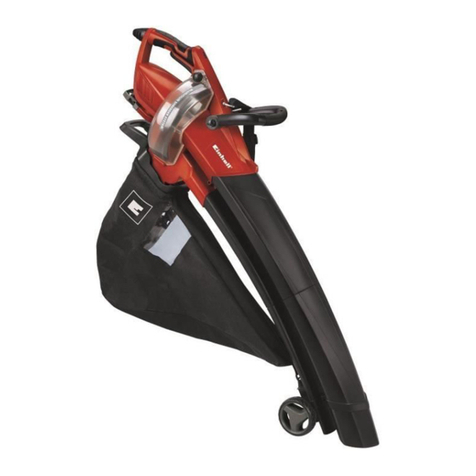
EINHELL
EINHELL GE-EL 3000 E Original operating instructions

Billy Goat
Billy Goat Z FORCE FZ1300H owner's manual
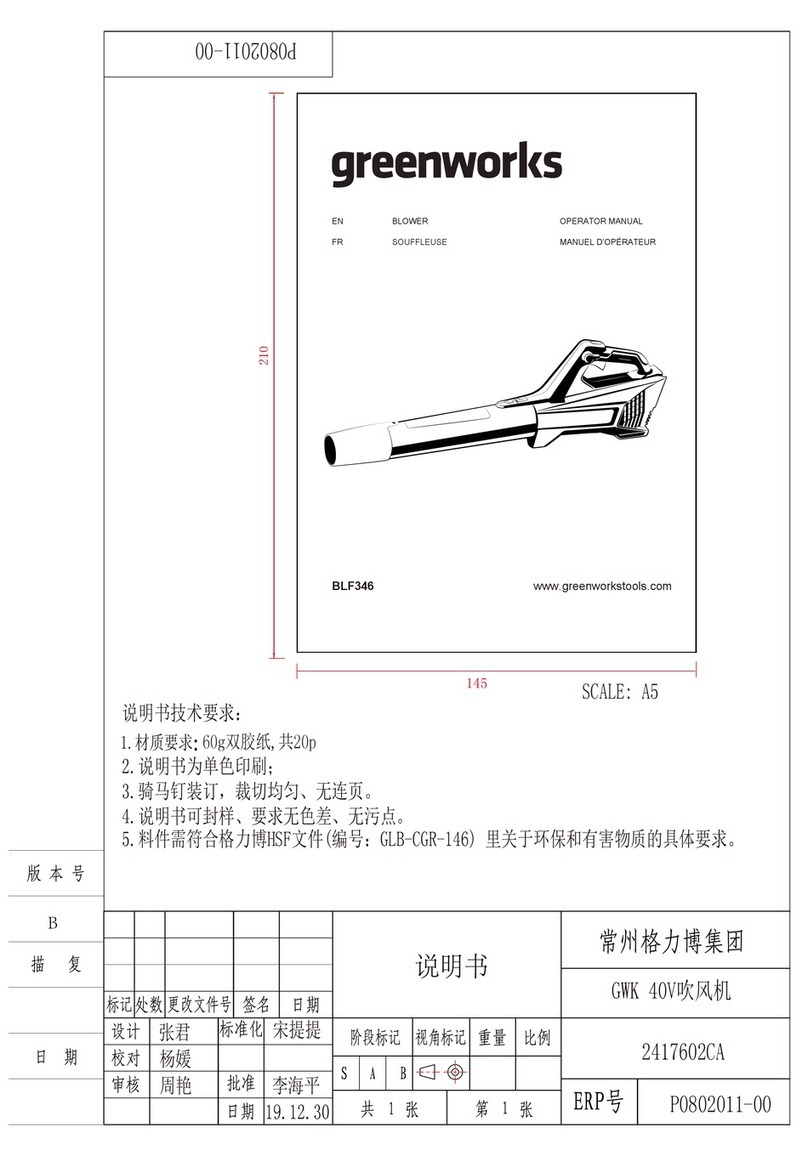
GreenWorks
GreenWorks 2417602CA Operator's manual
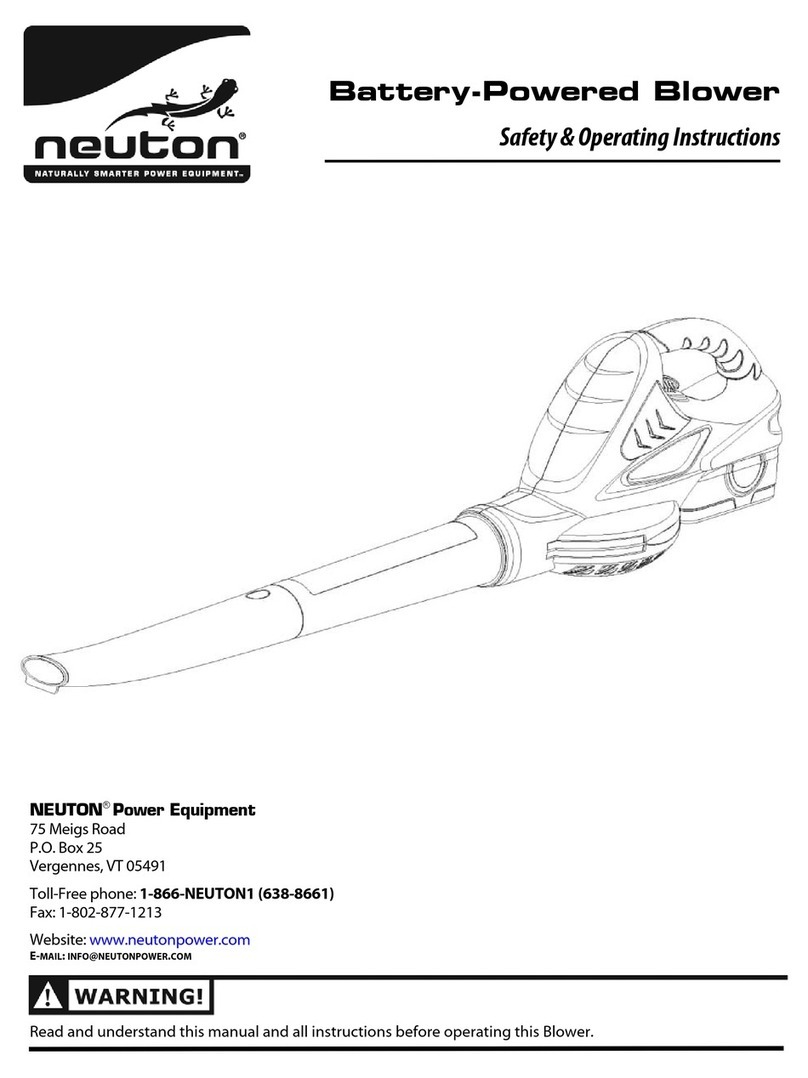
Neuton
Neuton Battery-Powered Blower Safety & Operating Instructions
